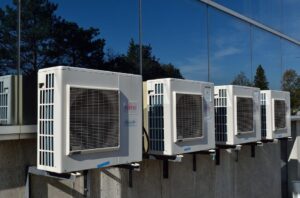Every homeowner should be accustomed to buying air filters. It is a regular part of home maintenance and neglecting this critical step could significantly reduce the efficiency of your HVAC system and lead to early system failure. Both indoor air quality and circulation efficiency depend on having clean, unclogged air filters. But to perform this simple air conditioning repair in Cupertino, CA you need to know the unit’s filter size as well as the desired MERV rating. You can get the size from the unit specs. But how do you decide on the right MERV rating and how much does it matter? Here is what you should know.
What is a MERV Rating?
MERV is the acronym for Minimum Efficiency Reporting Values. This rating measures the filter’s ability to trap airborne particles between 0.3 and 10 microns large. Particles in this range include dust, pollen, spores, dander, mites, and even some microbiology. The range of MERV ratings is from 1 to 20.
What do MERV Ratings Mean?
Think of it as a chain-link fence. With a regular fence, large objects get stopped but smaller things like tennis balls and ping pong balls pass through easily. But with a tighter woven fence, the tennis ball may no longer fit, but maybe ping pong balls still do. This is just like filters but on a much smaller scale. Low MERV numbers trap less and high MERV numbers trap more.
An example of a MERV rating would be MERV 10. The microns indicate how small the particles are and the percentage indicates how many of those particles are trapped by the filter. So, a MERV 10 rating filters smaller particles from 1 to 3 microns at 55% efficiency and larger particles from 3 to 10 microns at 85% plus efficiency. Basically, with each pass through the filter, half of the smaller particles are stopped along with most of the larger particles. And it will take two or three cycles through the filter to remove the majority of particles in this size range.
Low MERV for Average Air Quality
Lower MERV ratings from 1 to 8 are standard for most homes and businesses. These filters do not trap as many particles but are good for the usual suspects like lint, pollen, dust mites, sawdust, carpet fibers, and mold spores. Because they are not as dense as other filters and require less specific material they are often more affordable.
Medium MERV for High Air Quality

These filters range from MERV 8 to 12 and can filter particles as tiny as 1 micron. These types are filters are often used in both commercial and residential buildings that require especially clean air. Places like dental offices, hospitals, and laboratories benefit from these higher ratings because they filter out smaller particles with higher efficiency.
High MERV for Medical Grade Air Quality
These are the highest-quality filters ranging from MERV 12 to 20, though you very rarely see filters higher than 16. These types of filters often are reserved for facilities that require clean-room level safety and superb air quality–places like surgery facilities, inpatient care hospitals, and control of radioactive or carcinogenic processing areas.
Still have questions about which MERV filter is best for your home? Not sure how to choose? Contact our experts about air conditioning repair in Cupertino, CA.
The post Understanding MERV Ratings appeared first on Pelle Heating & Air Conditioning.

